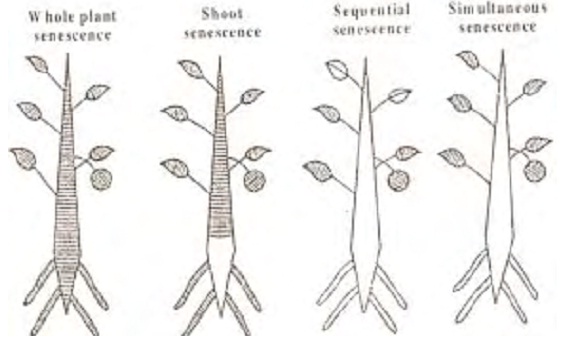Leopold in 1975 has proposed four kinds of senescence patterns:
Whole plant (Overall) senescence:
Whole plant (Overall) senescence:
The complete plant dies soon after ripening of the seeds.This is found in monocarpic plants that generate fruit and flower only once in their life cycle. The plants might be annual (example: rice, gram, mustard, wheat, and so on), biennials (example: cabbage, henbane) or perennials (example: certain bamboos and so on).

Figure: Types of senescence
Shoot (TOP) senescence:
The above-ground plant organs die off seasonally, to be renewed by growth from sub-terranian organs. This kind of senescence is found in some perennial plants that possess underground perennating structures such as rhizomes, corm, bulbs, and so on. The ground portion of the shoot dies each year after flowering and fruiting, however the underground portion (stem and root) survives and puts out new shoots again next year. Example: banana, ginger, gladiolus, and so on.
Sequential (Progressive) Senescence:
Sequential (Progressive) Senescence:
This is found mostly in perennial plants in which the tips of main shoot and branches remaining a meristematic state and carry on to generate new buds and leaves. The older leaves and lateral organs such as branches exhibit senescence and die and new ones gradually substitutes for them. Sequential senescence is obvious in evergreen plants. Example: Eucalyptus, Pinus and so on.
Simultaneous or Synchronous (Deciduous) senescence:
Simultaneous or Synchronous (Deciduous) senescence:
This is found in temperate deciduous trees like elm and maple. Such plants show seasonal (summer or winter) foliage senescence depending on the local stress. Pome and drupe deciduous fruit tress usually manifest winter shedding, while xerophytic species such as Zygophyllum shed foliage during the hot dry summer. Such a senescence of leaves or plant organs is termed as synchronous.
No comments:
Post a Comment